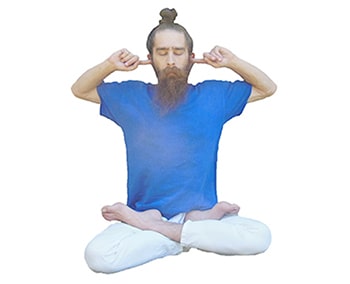
Bhramari Pranayama

In Sanskrit, Bhramari means "humming black bee" and Pranayama means "control of the life force energy" or "breathing exercises." This practice is a Vishama Vritti Pranayama practice, meaning "unequal ratio breathing" where the exhale is lengthened and includes Antara Kumbhaka, meaning "internal breath retention." This practice is described in the Gheranda Samhita and the Hatha Yoga Pradipika.
Practice
Sit in a Meditative Asana or a comfortable seated position.
Keep the back straight, shoulders muscles relaxed and eyes closed.
Close the right ear with the index finger of the right hand and close the left ear with the index finger of the left hand.
Raise the elbows parallel to the shoulders.
Inhale deeply and hold the breath for as long as possible and without strain.
Exhale slowly while making a buzzing sound that is like a flying Bumble Bee.
The six cleansing actions are intended to be the start of a Yoga practice in order to clean, strengthen, remove toxins and improve the flow of Prana through out the practitioner.
Yoga poses help to elongate and strengthen the muscles of the body as well as to calm the mind for the deeper spiritual practices of Yoga.
Breathing exercises are a great practice to remove carbon dioxide, increase lung capacity as well as being a good preparatory practice for the deepest spiritual practice of Yoga, Meditation.
The four body locks that makes up this practice give the practitioner the ability to hold or lock Prana in certain locations of the body. These practices also allow the practitioner to release blockages that may be holding the practitioner back.
The gestures in this practice include the whole body and are intended to awaken Prana, Chakras as well as Kundalini energy within the practitioner.
Meditation is the highest spiritual practice of Yoga which is why this practice is the most difficult practice to preform, but with correct knowledge and dedication, can be the most profound practice of Yoga.